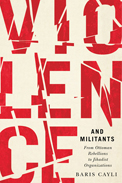
 |
Violence and Militants: From Ottoman Rebellions to Jihadist Organizations
by Baris Cayli
McGill-Queen’s University Press
This timely study of how militants rationalize the use of violence is hailed as the first book to address this complex relationship in a historical context. Comparing Christian rebel violence against the nineteenth-century Ottoman Empire with today’s Islamic jihadist terrorist attacks in the Middle East, the text provides a highly-detailed examination of the historical contexts that spawned the rise of historical rebel violence as contrasted to the birth of Hezbollah, Hamas, al-Qaeda, and ISIS. The narrative effectively dispels any confusion the layman might have about the agendas of historical rebellions of the region with these four jihadist groups, whose methods and goals vary from one another.
Cayli, a social and cultural critic, asks pertinent questions about the rationalization of violence, specifically referencing whether the cultural motives for violence are independent of time and geographic location. His thoughtful analysis, based on the inquiries of interdisciplinary studies of anthropologists, historians, philosophers, political theorists, and sociologists, renders the complicated topic as digestible for the more casual reader as it is keenly analytical for the academic reader. Cayli concludes that “although the motivation to use violence is independent of time and place, its application is culturally bound,” and “this process transcends different time periods and diverse places wherever perceived injustice is used to legitimize violence.”
Citing the socioeconomic factors for the application of historical and contemporary violence, Cayli clearly and methodically explains the differences between the greater use of the combined force of structural and cultural violence by today’s militant jihadists as contrasted to the limited use of either cultural or structural force by militant rebels of the Ottoman Empire. This thought-provoking and comprehensive discussion will likely prove influential in foreign policy and both domestic and international security concerns for decades to come.
RECOMMENDED by the US Review